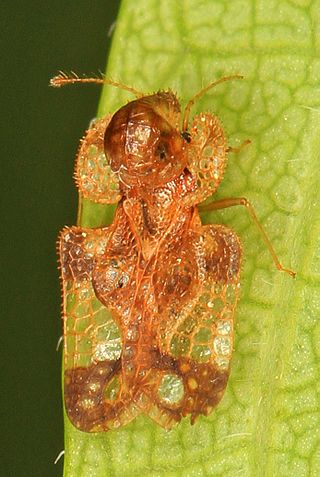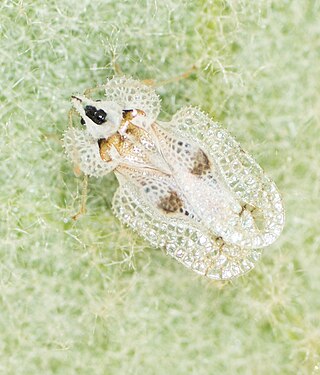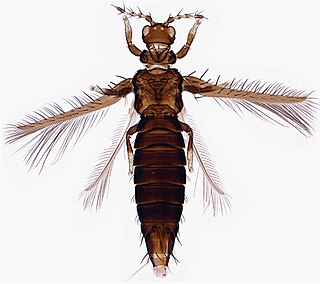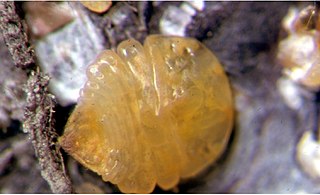
Acer pseudoplatanus, known as the sycamore in the British Isles and as the sycamore maple in the United States, is a species of flowering plant in the soapberry and lychee family Sapindaceae. It is a large deciduous, broad-leaved tree, tolerant of wind and coastal exposure. It is native to Central Europe and Western Asia, from France eastward to Ukraine, northern Turkey and the Caucasus and southward in the mountains of Italy and northern Iberia.

Elasmucha grisea, common name parent bug, is a species of shield bugs or stink bugs belonging to the family Acanthosomatidae. The term parent bugs includes also the other species of the genus Elasmucha and some species of the family Acanthosomatidae.

Anasa tristis is a species of bug in the family Coreidae. It is a major pest of squash and pumpkins, found throughout North America, and is a vector of the cucurbit yellow vine disease bacterium. These bugs can emit an unpleasant odor when disturbed. It is commonly known as the squash bug but shares this name with certain other species.

Psylla pyri, commonly known as the pear psylla or pear psyllid, is an insect in the family Psyllidae. Originating in Europe and Asia, it has spread to North America. It is a pest of pear trees, sucking the sap, damaging the foliage, flowers and fruit and diminishing the crop.

The Tingidae are a family of very small insects in the order Hemiptera that are commonly referred to as lace bugs. This group is distributed worldwide with about 2,000 described species.

Corythucha is a large genus of lace bug in the family Tingidae that is primarily distributed in the New World, especially North America. The genus includes pest species such as the “cotton or bean lace bug" as well as species that provide maternal care, such as C. hewitti (Drake)

Gargaphia solani is a subsocial species of lace bug commonly known as the eggplant lace bug. The species was described by Heidemann in 1914 after it aroused attention a year earlier in the United States as an eggplant pest around Norfolk, Virginia. Fink found that the species became an agricultural pest when eggplant is planted on a large scale.

Coccus viridis is a soft scale insect in the family Coccidae with a wide host range. It is commonly known as green scale or sometimes coffee green scale because it is a major pest of coffee crops throughout the world.

Euthyrhynchus floridanus, the Florida predatory stink bug, is a species of carnivorous shield bug in the family Pentatomidae, the only species in the genus Euthyrhynchus. It is native to the hottest parts of the southeastern United States and is considered beneficial because it feeds on many species of pest insects. They also feed on things such as grasshoppers and other small insects. This species also hunts in a pack, with up to twelve.

Corythucha gossypii, the cotton lace bug or bean lace bug, is a species of lace bug in the family Tingidae that is associated with cotton and a number of other host plants.
Leptoypha minor also known as the Arizona ash lace bug is a species of lace bugs in the family Tingidae. It is found in North America and is very common in California. It is considered a pest that causes twig and foliage damage to Oregon ash trees in addition to other types of ashes. Adult lace bugs can be found hibernating on ash trees during the winter, and during the spring, nymphs begin to emerge. Breeding continues throughout spring until October. L. minor differs from other common lace bugs in that they are generally a light-reddish brown and can grow up to 2 mm. They are compact in body form but lack the lacy lateral lobes of other lace bug species.
Corythucha juglandis, the walnut lace bug, is a species of lace bug in the family Tingidae. It is found in North America. It feeds on Tilia americana and overwinters in leaf litter. Both adults and nymphs are gregarious.

Aspidiotus destructor, the coconut scale, is a species of armoured scale insect in the family Diaspididae, found in many tropical and subtropical parts of the world. It is a serious pest of coconut and banana, and attacks a range of other fruiting trees and ornamental plants.
Cacopsylla pyricola, commonly known as the pear sucker, is a true bug in the family Psyllidae and is a pest of pear trees (Pyrus). It originated in Europe, was introduced to the United States in the early nineteenth century and spread across the country in the next century.

Corythucha confraterna, known as the sycamore lace bug, is a species of lace bug in the family Tingidae. It is found in Central America and North America. Active from spring to autumn, they gather under leaves and feed on plant sap, causing the leaves to wilt and be shed early. They feed not only on sycamore trees but also ash, hickory and mulberry trees. During the winter, they shelter in bark crevices, under fallen leaves or anywhere protected in close proximity to their food sources.
Balanococcus cordylinidis, the cabbage tree mealybug, is a species of insect in the family Pseudococcidae.

Selenothrips rubrocinctus, commonly known as the redbanded thrips, is a species of thrips in the family Thripidae. It was first described from the West Indies but may have originated in northern South America. It has spread to other parts of the world and now has a near pan-tropical distribution, occurring in North, Central, and South America, Africa, southern Asia, and Australasia.

Quadraspidiotus juglansregiae, commonly known as the walnut scale, is a species of armoured scale insect in the family Diaspididae. It is native to North America where it feeds on a wide range of ornamental and forest trees and bushes.

Toumeyella parvicornis is a soft scale insect in the family Coccidae with a wide host range. It is commonly known as pine tortoise scale because of the characteristic appearance of the mature females, which look like tiny tortoises up to 1/4 inch in diameter.

















